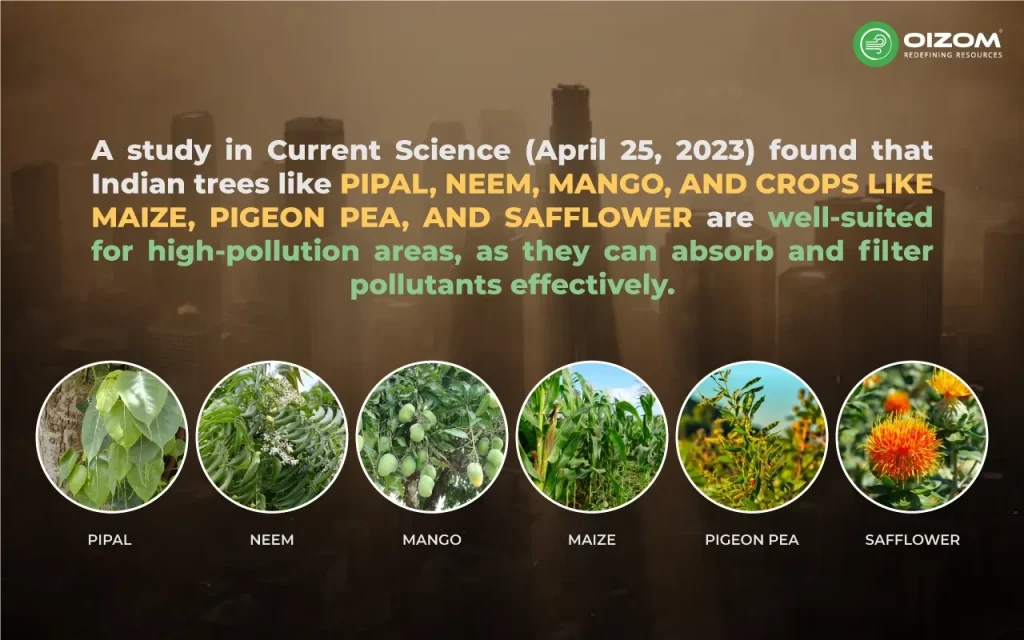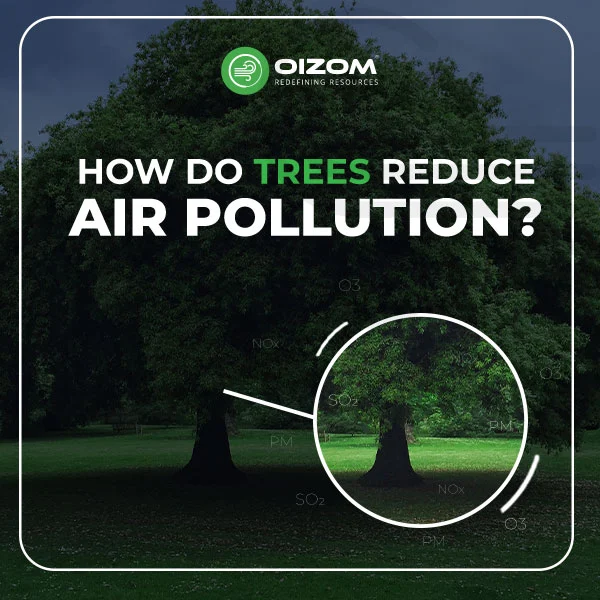Summary of Blog
Urbanization leads to increased air pollution, which is detrimental not only to our health but also to the environment. The answer may lie in trees; they do so much more than being nice-looking. Trees cool the air, which reduces the number of pollutants in the air. They conserve energy by shading, reducing the need for air conditioning. However, it gets even better: trees actually absorb toxic pollutants, such as SO2, NO2, CO, and ozone, through their leaves. Trees remove particulates from the air, release oxygen, and significantly reduce smog. Trees also absorb carbon dioxide, which helps combat global warming. Planting native trees in your neighborhood or backyard can be a significant undertaking. For high-tech solutions, cutting-edge sensor technology, such as Oizom’s air monitors, can be employed. They provide you with precise, real-time data to make more informed environmental decisions. By combining the natural air-purifying abilities of trees with advanced technology, we can create greener, healthier urban environments and achieve improved overall air quality.
How do Trees Reduce Air Pollution?: The Role of Green Spaces in Air Quality Improvement
The truth is straightforward: without trees, our cities would be uninhabitable. Try to imagine walking into a street filled with exhaust smoke, the sun rays reflected off glass skyscrapers, and no trees to temper the blistering afternoon heat. That is the day-to-day experience in much of our urban landscape, a reality in which rapid development lags behind clean air.
We usually consider trees to be mere background scenery, but they are more than that. They chill the air, dilute the strength of smog, and behave like natural filters that silently trap poisonous gases and fine particles. With each breath we take, they remind us that nature still has answers to the ills we inflict on it.
In this blog, we’ll uncover how trees reduce air pollution, why not all trees work the same way, and what role they play in creating healthier, more sustainable cities. If you’ve ever wondered how something as ordinary as a tree can fight something as massive as urban air pollution, read on. The science behind it is surprisingly powerful.
How Do Trees Help in Reducing Air Pollution?
We all travel daily, whether it is for work, dropping kids off at school, or for any other reason. We see tall skyscrapers, traffic congestion, and never-ending honking. The air is thick with exhaust fumes, making everything in the distance appear hazy and confused. You may be familiar with this scenario if you live in a city. It doesn’t make you smile, does it?
It is impossible to deny that such areas serve as reminders of a global issue: air pollution, which has negative implications for human health and the environment. In this article, I will discuss how trees can help mitigate air pollution and highlight their benefits and importance.
How Trees Capture Air Pollution
Do trees help reduce air pollution? Absolutely. According to the US National Park Service, planting trees improves air quality through three primary impacts:
- Changing the concentration of contaminants by lowering air temperatures.
- Reducing energy usage in buildings (especially for temperature control) reduces energy consumption from polluting sources.
- Directly eliminating pollutants from the air.
The two main types of mechanisms for purifying the air are:
Tiny Powerhouses: Leaves and Stomata
Tiny openings on tree leaves called stomata inhale harmful contaminants. Gases, including pollutants like SO2, NO2, CO, and ozone, are absorbed and broken down within the leaves’ inner surfaces. These stomata open and close, allowing the tree to absorb carbon dioxide (CO2) for photosynthesis while releasing oxygen (O2) as a byproduct.
Air Pollution Absorption
Trees filter particulate matter from the atmosphere by temporarily “catching” it on their vegetative surfaces. When it rains, these particulates wash off the tree, settle into the soil, or dissolve in water runoff. While trees cannot eliminate air pollution, they can significantly reduce its concentration, particularly in urban areas.
The Impact of Green Spaces on Local Air Quality
Trees have the potential to significantly limit people’s exposure to these gases. Trees provide numerous benefits to humans, making them the ideal alternative for protecting us from air pollution. Studies have demonstrated that tree leaves protect people from the toxicity of nitrogen oxides, which are generated by car exhaust and smog.
Cleaner Air for Everyone
Trees not only release clean oxygen for us to breathe, but they also help to improve air quality by eliminating pollutants and greenhouse gases from the environment. Every year, urban trees in the United States remove an estimated 711,000 metric tons of air pollution.
Trees act as filters. This means they are cleaning the air around them. As a result, planting trees in your yard is essential for protecting your family from various health hazards. While there are many benefits of trees, some of them are mentioned below. So, when people plan to add trees to their yards, they should consider these benefits in detail.
Reduced Smog Formation
Trees act as barriers, capturing airborne contaminants and contributing to the production of smog. This is especially critical in cities, where traffic and industrial emissions can generate a dense mist of smog that impairs visibility and health.
Trees can also help lessen the amount of smoke produced by fires. According to a study, the amount of smoke a fire produces varies depending on the type of fuel. However, the study concludes that the presence of trees lowers the influence of such smoke on human health. Trees can also help minimize the formation of black soot and carbon monoxide, which can cause significant health concerns. Additionally, smoke from flames can cause carbon monoxide poisoning. This produces chest discomfort and might even lead to unconsciousness.
Common Misconceptions About Trees and Air Pollution

When we consider trees as natural air filters, it is easy to get overexcited by a few myths. One of the most prevalent misconceptions is that trees can single-handedly remove urban air pollution. Although their contribution is substantial, research indicates that even in the United States, where urban trees strip away approximately 711,000 metric tons of pollutants annually, this only accounts for a fraction of the overall emissions. Trees limit pollutant exposure and improve surrounding conditions, but handling smog or traffic pollution also involves cutting emissions at their source.
Another common perception about trees is that all are equally efficient in purifying the air. The reality is that the ability is highly variable among species. Studies indicate that conifers, including pine and cypress, with their dense foliage and evergreen structure, are among the most effective natural filters. Likewise, Indian species such as neem, pipal, and mango have been highly effective in removing pollutants. Planting the correct trees for the local climate and situation is more important than simply planting more of any particular type.
Size is another source of confusion. Most people take for granted that bigger trees necessarily equal more effective pollution control. Although large canopies can capture more particulates, efficacy is more a function of the microscopic characteristics of the leaf surface texture, waxy coatings, and stomata activity. Actually, a smaller evergreen tree that filters throughout the year might be more effective than a large deciduous tree that sheds its leaves during winter.
Lastly, there is the idea that tree planting can fix air pollution issues in urban areas. Trees do indeed contribute by cooling the air, mitigating smog, and purifying harmful gases, but they cannot substitute for emission controls or the transition to clean energy. Their primary contribution is in supporting these efforts, not replacing them.
Practical Tips: How You Can Support Cleaner Air With Trees
If you plan to plant trees in your yard, you should include all the reasons mentioned below:
Planting Trees in Your Yard or Community
Planting more trees is one of the most effective strategies to reduce air pollution. Growing trees, whether in your own yard or through community initiatives, can significantly improve local air quality. Consider planting tree species that are native to your area and have a high capacity to absorb pollutants.
Jun Yang, an urban ecologist at the Center for Earth System Science at Tsinghua University in Beijing, conducted the research. He discovered that pine and cypress trees were the finest pollution filters. The London Plane, Silver Maple, and Honey Locust also scored higher than usual because conifers’ canopy structures allow them to capture pollutants more efficiently.
Furthermore, evergreen plants, such as conifers, can function as filters all year. Although these species are pretty successful, Jun Yang emphasizes the relevance of selection and environment. Just because one tree absorbs pollutants extremely well does not mean it should or can be planted everywhere. When planting, consider factors such as maintenance and lifetime.
Did you know: Research conducted by a student at PDEU found that the Heaven Tree (Ailanthus excelsa), when planted near a building, provides ample shade, reduces air temperature, and improves outdoor thermal comfort. Additionally, it is highly effective at absorbing suspended particulate matter.
A study in Current Science (April 25, 2023) found that Indian trees, such as pipal, neem, and mango, as well as crops like maize, pigeon pea, and safflower, are well-suited for high-pollution areas, as they can effectively absorb and filter pollutants.

Support urban forestry programs in your city or town. These efforts focus on planting and maintaining trees in urban areas, offering significant environmental and social benefits. Support local tree-planting activities, preservation regulations, and other efforts to increase the urban tree canopy. Moreover, you can discuss the importance of trees with your friends and family and encourage them to support tree-planting organizations.
Conclusion
Ultimately, as everyone is aware, trees play a crucial role in reducing air pollution. Understanding how trees filter the air is critical as we work toward a greener, healthier future. By harnessing the extraordinary air-purifying properties of trees, we can build more sustainable communities, enhance public health, and mitigate the negative effects of air pollution. But have you ever considered that to determine if the air quality is good or poor, we first need accurate data?
This is where Oizom comes in. Using sensor-based technology to monitor air quality, Oizom measures 30+ parameters in real-time, ensuring the highest accuracy even in extreme environmental conditions. Our web-based air monitoring software provides real-time environmental data to facilitate better decision-making. The Oizom Terminal air monitoring software provides actionable insights for authorities, communities, and industries, enabling them to make informed decisions and improve air quality.
FAQs
Trees absorb pollutants through their leaves and filter particulates, while also releasing oxygen into the atmosphere.
Monitoring tracks pollution levels and demonstrates the effectiveness of tree planting in improving air quality.
No, but they significantly reduce it when combined with other measures, such as emission control and monitoring.






